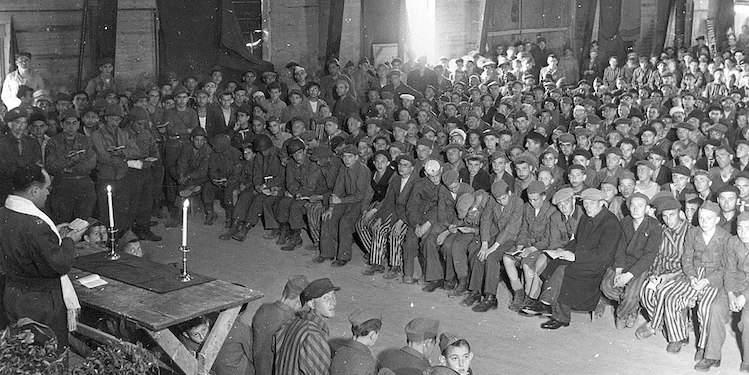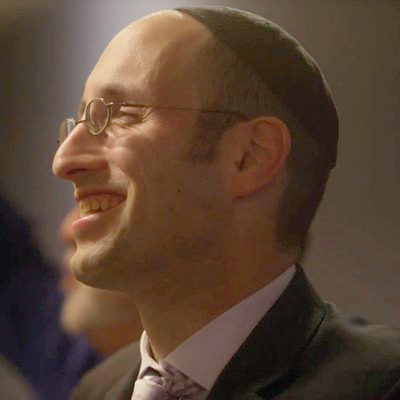Second Passover
When survivors of Buchenwald, two days after liberation, gathered over matzah to celebrate their freedom.

On April 13, 1945, a unique service centered on Passover was held in the liberated Buchenwald concentration camp. Some 1,500 survivors gathered at the Kino Halle, the auditorium that had until that point been used by Nazis to watch movies when they took brief respite from murdering Jews. The service was led by Rabbi Herschel Schacter, a chaplain in Patton’s Third Army who only several days earlier had entered the camp uttering the immortal words Shalom aleichem Yidden, ihr sind frei—Peace be unto you, my fellow Jews, you are free.
The rabbi spoke about the Exodus, linking liberations past and present in words that would be remembered by the survivors decades later. One of them, Jack Breitkopf, would recall on the 25th anniversary of the day: “How we crowded into the house that the Nazis had used and listened to Rabbi Schacter speak of freedom, of the meaning of Passover. What he did, no money can pay back for the love and warmth he gave us.” The chaplain joined his words with the distribution of the central food of Passover: unleavened bread. Schacter’s biographer, Rafael Medoff, described the scene:
He broke the matzahs into as many small pieces as possible and distributed them to the eager attendees, for whom they represented their Jewish identity that had been suppressed for so long. “They pounced on the matzoh crumbs. One man jumped up on the lectern holding matzoh, and shouted out the hamotzi and shehecheyanu blessings.” The shehecheyanu is a declaration of gratitude for a special occasion, such as a holiday or the wearing of a new garment for the first time. But in this case, Schacter later observed, “What occasion is more appropriate for shehecheyanu than their delivery from death?”
Thus the service was, in its own way, a true embodiment of the seder. There was, ostensibly, one problem: Passover had already…passed. As Medoff recounts, the matzah distributed was composed of mere crumbs because it was but a remnant, left over from a seder the chaplain had held for Jewish servicemen at the Rhine River almost two weeks before. But rightly understood, this makeshift makeup seder for those unable to observe Passover was also rooted in Jewish history and divine commandment.
The month following Passover in the Jewish calendar is marked by commemorations of modern moments in Jewish history, both the horrific and the miraculous: There is Yom Ha-Shoah, Holocaust Memorial Day, observed in Israel on the date of the Warsaw Ghetto uprising; Yom Ha-Zikaron, a memorial day for Israeli soldiers murdered in battle; Yom Ha-Atzamut, celebrating Israeli Independence; and Yom Yerushalayim, rejoicing in the liberation of ancient Jerusalem.
In the process of marking these moments, a more ancient date, once central to Israelite observance in Temple times, has been largely forgotten. It is called Pesach Sheni, the “Second Passover;” and Rabbi Schacter’s belated “seder” illustrates how this now-obscure day may actually embody Jewish history more than Passover itself.
The origin of “Second Passover” is described in the book of Numbers, in a tale that occurred one year after the Exodus itself. Remembering the liberation a year before, the Israelites in the desert assemble to sacrifice the paschal lamb, as they had in Egypt 12 months prior. Several Israelites, however, had just recently buried a dead body; this contact necessitated a seven-day ritual defilement, preventing them from engaging in sacrificial rituals associated with the tabernacle:
And there were certain men, who were defiled by the dead body of a man, that they could not keep the passover on that day: and they came before Moses and before Aaron on that day. And those men said unto him, We are defiled by the dead body of a man: wherefore are we made less, that we may not offer an offering of the Lord in his appointed season among the children of Israel?
The complaint asserted by the defiled Israelites bespeaks not only religious reverence but also national identity. The paschal offering was the central civic ritual of ancient Israel, compared by both the Bible and later sources to circumcision. For these individuals, defiled by the dead, to be sidelined from the celebration was to be cut off from “among the children of Israel,” from their very portion in the people itself.
In response, the Almighty informs Moses that from then on, a day would be set aside, a month after Passover, for the bringing of the Paschal offering by those previously prevented from doing so—for those in a state of defilement because of the burial of a loved one, and for those who could not reach Jerusalem in time for Passover.
Though the day is not named in the Bible, it was Jewish tradition that lovingly bestowed the phrase “Second Passover” upon it, capturing how it symbolized a second chance to celebrate freedom, the potential for a second opportunity for celebration when the first was lost.
And this, in turn, reflects the nature of Jewish history itself. When Menachem Begin was told by Jimmy Carter that he faced Israel’s last chance to make peace, Begin told the press, “This, of course, is one of the important events of our time.” He added: “If people say this is a fateful meeting, we disagree. The fate of our people should not depend on any meeting—this meeting or any other. Our people lived thousands of years before Camp David and shall continue to exist thousands of years after.” For the Jews, Begin continued, “there are no last opportunities or chances.” Centuries after the Temple was destroyed, Jews would mark “Second Passover” by eating a bit of the matzah left over from the month before, pondering when the next chance of celebrating freedom would occur in Jewish history.
It is therefore no coincidence that Schacter, looking back at that moment in Buchenwald, called it a “Second Passover.” It was not yet a month after the festival, as Schacter acknowledged, but “it was Pesach Sheni in the most meaningful sense for these Jews, who were unable to have an actual Pesach.” And that ingestion of matzah in a Nazi movie theater allows us to understand the sublime symbolism of the day itself. Is there a better parallel to the origin of Second Passover—those defiled by the dead ultimately celebrating freedom—than a liberation celebration of survivors following an encounter with the ultimate embodiment of death? And is there a biblical day, established so many millennia ago, whose symbolism more strikingly joins together all the modern markings this month, of the Holocaust and the birth of Israel, of Jewish life after Jewish death?
Two weeks after the first service in Buchenwald, another was held on April 27, which happened to be “Second Passover” itself. This time, the chaplain had prepared enough matzah for all. Schacter’s assistant, Hyman Schulman, explained the service in a letter to his wife: “Yesterday was Pesach Schanee, you know,” adding about the survivors, that “the miraculous thing about it was that not one of them ate a piece of matzah until the chaplain said the blessing over the Matzoh.” One participant, Avraham Schneur, told Medoff that up till that point in the camps he had been incapable of faith. Suddenly, the chaplain intoned the memorial prayer for those who had been murdered, and he realized that this included “my father my mother, and my brother, and perhaps also my sisters.…When I heard the prayer, the knowledge that they were gone took on a different character; it became absolute.” And “from then on I knew I had to recite a prayer for them. When I recovered, I noted that two lines were forming; at the front of one line the rabbi was handing out matzo to everyone, and in the other line they were handing out prayer books. I received a prayer book and knew that I was resuming being a Jew.”
Thus did Schneur come to terms with Jewish death, and embrace Jewish life, thereby embodying Jewish history in its totality. It is safe to say that for most reading this article, a “Pesach Sheni” will not be central to their celebrations this year. But if we take pains to mark it, it will render our more modern commemorations more profound, reminding us of what it means to be part of a nation that has no last chance, and will never die.
This essay was originally published in Commentary.
When survivors of Buchenwald, two days after liberation, gathered over matzah to celebrate their freedom.
When survivors of Buchenwald, two days after liberation, gathered over matzah to celebrate their freedom.

